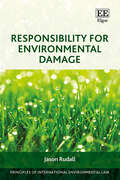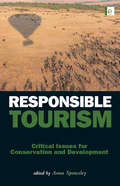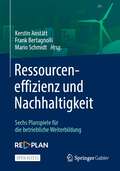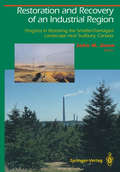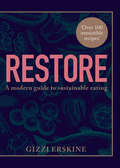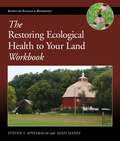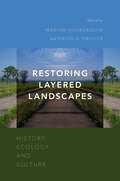- Table View
- List View
Responsibility and Liability in the Context of Transboundary Movements of Hazardous Wastes by Sea: Existing Rules and the 1999 Liability Protocol to the Basel Convention (Hamburg Studies on Maritime Affairs #29)
by Jan AlbersThe term “hazardous wastes” covers a wide range of disused products and production wastes generated not only in industrial sectors, but also in all areas of everyday life. Hazardous wastes are to a large extent shipped by sea to third countries for recycling or disposal. While the procedural requirements for such movements are laid out in the 1989 Basel Convention, explicit rules of responsibility and liability for resulting damages are neither provided by the Basel Convention nor by other international conventions. The Liability Protocol to the Basel Convention of 1999 has not yet entered into force. This book examines the existing rules of responsibility and liability applying to States and private persons and outlines the conditions under which liability may be incurred. Subsequently, the advantages and shortcomings of the 1999 Liability Protocol are analyzed. Although this Protocol faces substantial political headwind, from a legal perspective it includes principally useful and reasonable approaches and should therefore be ratified.
Responsibility for Environmental Damage (Principles of International Environmental Law series)
by Jason RudallEngaging with one of the most consequential issues of our time, this book provides a thoughtful analysis of responsibility for environmental damage under international law. It conceives of responsibility in a comprehensive way, tackling the legal responsibility, liability and accountability of state and non-state actors for harm they cause to the environment.Responsibility for Environmental Damage traverses the primary and secondary rules of international law, the responsibility, liability and accountability of states, international organizations, corporations and individuals, as well as existing, new and emerging regulatory frameworks. It engages with the consequences of environmental harm, appraising both orthodox legal doctrines and cutting-edge questions like shared responsibility, equitable considerations, full reparation, response measures under liability regimes, corporate responsibility, ecocide and responsibility for climate change, amongst many others. In doing so, the book evaluates whether the law is equipped to deal with the novel challenges that environmental damage presents and argues that new legal tools are needed to effectively tackle some of the most significant threats to our planet.This book is an essential resource for undergraduate and postgraduate students as well as scholars who conduct research on responsibility, liability or accountability for environmental damage in the areas of public international law, international environmental law, human rights, international criminal law and international economic law. International law practitioners, judges, arbitrators, policymakers, and those working for think-tanks and NGOs will similarly benefit from this valuable work.
Responsibility in Environmental Governance: Unwrapping the Global Food Waste Dilemma (Environmental Politics and Theory)
by Tobias GumbertThis book provides a comprehensive study of the notion of responsibility in environmental governance. It starts with the observation that, although the rhetoric of responsibility is indeed all-pervasive in environmental and sustainability-related fields, decisive political action is still lacking. Governance architectures increasingly strive to hold different stakeholders responsible by installing accountability and transparency mechanisms to manage environmental problems, yet the structural background conditions affecting these issues continue to generate unevenly distributed, socially unjust, and ecologically devastating consequences. Responsibility in Environmental Governance develops the concept of responsibility as an analytical approach to map and understand these dynamics and to situate diverse meanings of responsibility within larger socio-political contexts. It applies this approach to the study of food waste governance, uncovering a narrow governance focus on accountability, optimization, and consumer behavior change strategies, opening up spaces for organizing more democratic solutions to a truly global problem.
Responsible Citizens and Sustainable Consumer Behavior: New Interpretive Frameworks (Routledge-SCORAI Studies in Sustainable Consumption)
by Pietro LanziniThere is broad consensus on the need to shift to a new paradigm of lifestyles and economic development, given the un-sustainability of current patterns. Given this, research on consumer behavior is to play a crucial role in shedding light on the motives underpinning the adoption of responsible behaviors. Stemming from a thorough discussion of existing approaches, this book argues that the perspective of analysis has to be modified. First, acknowledging that a profile of the responsible consumer does not exist since all of us can be more or less sustainable and environment-friendly: the sustainability of an individual should not be considered as given, being something dynamic that changes according to both subjective and contextual factors. Moreover, the book hypothesises that integrating dimensions and perspectives that have been so far overlooked by mainstream research will help deconstruct responsible behaviors adopting a flexible and holistic approach. Relevant policy implications are discussed, and empirical research on responsible behaviors is illustrated. This book will be of great interest to students and scholars of consumer behavior, sustainable consumption, environmental psychology and environmental studies in general.
Responsible Citizens and Sustainable Consumer Behavior: New Interpretive Frameworks (Routledge-SCORAI Studies in Sustainable Consumption)
by Pietro LanziniThere is broad consensus on the need to shift to a new paradigm of lifestyles and economic development, given the un-sustainability of current patterns. Given this, research on consumer behavior is to play a crucial role in shedding light on the motives underpinning the adoption of responsible behaviors. Stemming from a thorough discussion of existing approaches, this book argues that the perspective of analysis has to be modified. First, acknowledging that a profile of the responsible consumer does not exist since all of us can be more or less sustainable and environment-friendly: the sustainability of an individual should not be considered as given, being something dynamic that changes according to both subjective and contextual factors. Moreover, the book hypothesises that integrating dimensions and perspectives that have been so far overlooked by mainstream research will help deconstruct responsible behaviors adopting a flexible and holistic approach. Relevant policy implications are discussed, and empirical research on responsible behaviors is illustrated. This book will be of great interest to students and scholars of consumer behavior, sustainable consumption, environmental psychology and environmental studies in general.
Responsible Tourism: Critical Issues for Conservation and Development
by Anna Spenceley?Responsible Tourism presents a wide variety of valuable lessons learned in responsible tourism initiatives in Southern Africa that many tourism practitioners can use in their efforts to make the tourism sector work for the poor and for the environment.? Dr Harsh Varma, Director, Development Assistance Department, World Tourism Organization (UNWTO) ?For those interested in how tourism can assist in the economic and social development of societies in need, Responsible Tourism effectively integrates scales and types of knowledge to present an informative, stimulating perspective. It will be on my bookshelf.? Steve McCool, Professor Emeritus, Wildland Recreation Management, University of Montana ?Responsible tourism is one of the most significant contemporary issues for tourism scholars and practitioners alike. This useful and clearly written collection of new research demonstrates the innovations in responsible tourism occurring within southern Africa and provides lessons for international research and practice.? Professor Christian Rogerson, University of Witwatersrand, South Africa Conservation efforts are often seen to be in conflict with local livelihoods and resource use - the ?park versus people? debate. ?Responsible tourism? and ?Ecotourism? are often invoked as a third way that serve both ends. Yet do they actually work in practice? This volume delves deep into practice in southern Africa, the hotbed of innovation on the issue, and provides a comprehensive, evidence-based examination of what works and what fails, using a wealth of information from scholars and practitioners working in the region. This book opens with an overview of the issues, looks at what sustainable and responsible tourism are in practice and how they may contribute to conservation, poverty alleviation and local economic development. Part 1 examines policies and institutional activities in responsible tourism by governments, donor agencies and nongovernmental organizations, and addresses the market for responsible travel. Part 2 considers responsible nature-based tourism, the economics of wildlife tourism and ecotourism, transfrontier conservation areas, ecological impacts of tourism and other issues. Part 3 looks at more detailed case studies of community-based tourism projects, and highlights the reasons for successes and failures in this sector. The book concludes with a synthesis of the key findings with implications for policy, destination planning, business management, and future private sector and donor interventions. Published with the Southern African Sustainable Use Specialist Group (SASUSG) of IUCN
Responsible Tourism: Critical Issues for Conservation and Development
by Anna Spenceley?Responsible Tourism presents a wide variety of valuable lessons learned in responsible tourism initiatives in Southern Africa that many tourism practitioners can use in their efforts to make the tourism sector work for the poor and for the environment.? Dr Harsh Varma, Director, Development Assistance Department, World Tourism Organization (UNWTO) ?For those interested in how tourism can assist in the economic and social development of societies in need, Responsible Tourism effectively integrates scales and types of knowledge to present an informative, stimulating perspective. It will be on my bookshelf.? Steve McCool, Professor Emeritus, Wildland Recreation Management, University of Montana ?Responsible tourism is one of the most significant contemporary issues for tourism scholars and practitioners alike. This useful and clearly written collection of new research demonstrates the innovations in responsible tourism occurring within southern Africa and provides lessons for international research and practice.? Professor Christian Rogerson, University of Witwatersrand, South Africa Conservation efforts are often seen to be in conflict with local livelihoods and resource use - the ?park versus people? debate. ?Responsible tourism? and ?Ecotourism? are often invoked as a third way that serve both ends. Yet do they actually work in practice? This volume delves deep into practice in southern Africa, the hotbed of innovation on the issue, and provides a comprehensive, evidence-based examination of what works and what fails, using a wealth of information from scholars and practitioners working in the region. This book opens with an overview of the issues, looks at what sustainable and responsible tourism are in practice and how they may contribute to conservation, poverty alleviation and local economic development. Part 1 examines policies and institutional activities in responsible tourism by governments, donor agencies and nongovernmental organizations, and addresses the market for responsible travel. Part 2 considers responsible nature-based tourism, the economics of wildlife tourism and ecotourism, transfrontier conservation areas, ecological impacts of tourism and other issues. Part 3 looks at more detailed case studies of community-based tourism projects, and highlights the reasons for successes and failures in this sector. The book concludes with a synthesis of the key findings with implications for policy, destination planning, business management, and future private sector and donor interventions. Published with the Southern African Sustainable Use Specialist Group (SASUSG) of IUCN
The Responsible Traveller: A Practical Guide to Reducing Your Environmental and Social Impact, Embracing Sustainable Tourism and Travelling the World With a Conscience
by Karen EdwardsThe Responsible Traveller is your ticket to sustainable and ethical travel. This pocket-sized book provides the knowledge and tools that can help you to explore the world with a lighter footprint.Whether you travel out of curiosity, to find respite, to remind yourself of how vast and wonderful our planet is, or in search of life-shaping adventures, having the freedom to explore can be exhilarating and hugely rewarding. However we owe it to the people, cultures, ecosystems and wildlife that we encounter along the way to travel with respect; to preserve our beautiful world for generations to come.The Responsible Traveller will show you how to make actionable changes that result in more thoughtful and adventurous travels, while also doing our very best for Planet Earth. Through case studies and storytelling, you’ll learn about the environmental and social effects of tourism and gain a deeper understanding of cultural sensitivity. And through simple, achievable tips and practical lifestyle changes, you’ll discover how you can make an almighty difference in reducing your impact. Empowered with this information, perhaps your next adventure will be inspired by consideration, understanding and compassion.
Ressourcen-Umwelt-Management: Wasser · Boden · Sedimente (Geowissenschaften und Umwelt)
by M. Huch H. GeldmacherRaumordnung und Landschaftsplanung müssen heutzutage eine Vielzahl von Ansprüchen berücksichtigen. Je dichter eine Region besiedelt ist, um so stärker verschärfen sich die jeweiligen Nutzungskonflikte durch den Druck des natürlichen Bevölkerungswachstums und durch die hohe Mobilität in Beruf und Freizeit. Zur Verfügung stehende Flächen und gewinnbare Rohstoffe müssen daher so verwaltet werden, daß sie auch zukünftig sicher genutzt werden können. Stattdessen beeinflussen schadstoffbelastete Böden und Sedimente, aber auch Niederschlags- und Bergbauabwässer die Qualität von Grundwasser, Baugrund und Baustoffen.In diesem Buch werden verschiedene Aspekte des Managements von Wasser, Boden und Sedimenten aus geowissenschaftlicher Sicht diskutiert. Das kommunale Management ist angesichts immer knapper werdender Ressourcen heute mehr denn je gefordert, für die anstehenden Probleme langfristige Lösungen zu erarbeiten.
Ressourceneffizienz und Nachhaltigkeit: Sechs Planspiele für die betriebliche Weiterbildung
by Kerstin Anstätt Frank Bertagnolli Mario SchmidtKlimaschutz und Ressourceneffizienz gehen häufig Hand in Hand. Mit Spiel und Spaß ressourceneffizientes Handeln fördern – das ist die Devise der Planspiele rund um das Thema Energie- und Materialeffizienz, die in diesem Buch vorgestellt werden. Die Planspiele schließen eine Lücke im betrieblichen Weiterbildungsangebot und bilden ein niederschwelliges Angebot, mit dem ressourceneffizientes Denken und Handeln spielerisch in Unternehmen eingeführt werden kann. Unternehmen aller Art können gleich auf mehrere Arten von den in den Spielen vermittelten Kenntnissen und Methoden profitieren: Durch Ressourceneffizienz-Maßnahmen werden sowohl deutliche Kosteneinsparungen erzielt als auch ein Beitrag zum Klimaschutz durch die Minderung von Treibhausgasemissionen geleistet. Dies wirkt sich nicht zuletzt positiv auf die Wettbewerbs- und die Innovationsfähigkeit aus. Darüber hinaus werden die Mitarbeiter intern mit einem attraktiven und kurzweiligen Schulungsangebot weiterqualifiziert. Die Interaktion im Spiel involviert die Mitarbeiter aktiv und motiviert sie, ihr Wissen produktiv einzubringen. Das Ergebnis sind neue Ideen für noch mehr Effizienz im Unternehmen und gleichzeitig für mehr Klimaschutz. In diesem Open Access-Buch werden sowohl das fachliche Hintergrundwissen für die in den Spielen vermittelten Methoden beschrieben als auch konkrete Anleitungen zur Durchführung der Spiele gegeben.
Restoration and Development of the Degraded Loess Plateau, China (Ecological Research Monographs)
by Atsushi Tsunekawa Guobin Liu Norikazu Yamanaka Sheng DuThis book presents state-of-the-art scientific evidence and technological innovations to restore lands on the Loess Plateau of China, known worldwide for its serious land degradation and desertification problems. Supported by a rapidly developing Chinese economy and the dissemination of effective technology, the Grain-for-Green Project and Western Development Action launched by the Chinese government have resulted in successful ecological restoration and protection over the past 30 years. These programs have contributed not only to conservation of soil and water, but also to economic development. At the same time, however, these developmental interventions have brought new challenges that have not yet been fully addressed. The book describes (1) case studies of success and failure in practice, including rare success stories of combating desertification; (2) technical issues such as erosion control and breeding of stress-tolerant plant species, and socioeconomic measures taken by the Chinese government and lending policies with support from the World Bank; and (3) comprehensive measures against desertification, such as water and wind erosion, salinization, and deforestation. This volume is recommended for researchers and students above the undergraduate level in diverse fields including soil science, rural engineering, social technology and civil engineering, biology, ecology, climatology, physical and human geography, and developmental economics, among others. It also serves as a valuable resource for engineers, government officials, and NPOs and NGOs involved in afforestation, ecological restoration, combating desertification, disaster prevention, and sustainable rural development.
Restoration and Recovery of an Industrial Region: Progress in Restoring the Smelter-Damaged Landscape Near Sudbury, Canada (Springer Series on Environmental Management)
by John M. GunnSudbury, Ontario is one of the world's most polluted areas. A century of industrial activities has resulted in thousands of acidified lakes and vast areas of denuded land. This book describes, in a manner accessible to a wide audience, the damage and the efforts at environmental restoration at Sudbury which resulted in its winning a United Nations award in 1992 for land reclamation. The book has been written by a distinguished group of contributors, ranging from experts in acid rain and land reclamation to environmental engineers and toxicologists.
Restoration of Boreal and Temperate Forests (Integrative Studies in Water Management & Land Development)
by John A. StanturfThis substantially updated new edition reflects the growing recognition that large areas of forests are degraded globally. This edition describes forest restoration in the context of rapid social, economic, environmental, and climate change. Covering the last decade's significant advances in forest restoration concepts and practice, this edition has 16 new chapters and 19 thoroughly revised chapters. This book is an excellent source of information for researchers, managers, policymakers, and graduate students in forestry and ecology.
Restoration of Boreal and Temperate Forests (Integrative Studies in Water Management & Land Development)
by John A. StanturfThis substantially updated new edition reflects the growing recognition that large areas of forests are degraded globally. This edition describes forest restoration in the context of rapid social, economic, environmental, and climate change. Covering the last decade's significant advances in forest restoration concepts and practice, this edition has 16 new chapters and 19 thoroughly revised chapters. This book is an excellent source of information for researchers, managers, policymakers, and graduate students in forestry and ecology.
Restoration of Coastal Dunes (Springer Series on Environmental Management)
by M. Luisa Martínez, Juan B. Gallego-Fernández and Patrick A. HespThe continuously growing human population along the world’s coasts will exacerbate the impact of human activities on all coastal environments. Restoration activities will therefore become increasingly important. In particular, sandy shores and coastal dunes will require significant restoration efforts because they are preferred sites for human settlement, industrial and urban development and tourism. With this book experts in the field present a comprehensive review of restoration studies and activities, where ‘successful’ and ‘failed’ studies or approaches from around the world are contrasted and compared. A major asset the book provides is a compendium of studies showing that coastal dune restoration has many definitions and thus leads to many different actions. This volume addresses those with an interest in conservation ecology and biology, coastal dune dynamics and geomorphology, and coastal management who are seeking information on the different strategies for coastal dune restoration applied in different regions of the world. Finally, it will be a valuable resource for coastal scientists and planners, as well as for local and state officials, residents of coastal communities, environmental advocates and developers.
Restore
by Gizzi Erskine‘Gizzi’s recipes are creative, seriously satisfying and packed full of flavour.’ BBC Good Food ‘One of the most talked-about chefs of 2020 … a trailblazing approach to eating better and more sustainably without skimping on flavour’ GQ ‘Recipes that are good for the earth and good for the soul.’ The Times
Restoring Communities Resettled After Dam Construction in Asia (Routledge Special Issues on Water Policy and Governance)
by Mikiyasu Nakayama and Ryo FujikuraThe rapid economic expansion and population growth of developing countries in Asia has led to increasing demands for water and energy. To meet these demands, large dam development projects have been completed, which has inevitably caused involuntary resettlement. In order to support these projects, dam developers must find appropriate ways to ensure adequate livelihood reconstruction for resettled individuals. Resettlement causes both short-term and long-term effects (both positive and negative) for the relocated populations, meaning that in order to evaluate the larger impact of such projects long-term post-project evaluations must be carried out. However, post-project evaluations by international donors have typically been conducted within a few years after completion; the long-term impact of such projects is seldom evaluated.This book aims to fill this gap. A study team composed of researchers from Indonesia, Japan, Lao PDR, Sri Lanka, and Turkey has conducted ten case studies focusing on resettled individuals satisfaction, opportunities offered, and income generation. The volume provides an overview of the ten case studies, which were carried out across five countries. It also discusses how a compensation programme should be designed and what sort of options should be presented to resettled individuals for their maximum benefit.This book was originally published as a special issue of the International Journal of Water Resources Development.
Restoring Communities Resettled After Dam Construction in Asia (Routledge Special Issues on Water Policy and Governance)
by Mikiyasu Nakayama Ryo FujikuraThe rapid economic expansion and population growth of developing countries in Asia has led to increasing demands for water and energy. To meet these demands, large dam development projects have been completed, which has inevitably caused involuntary resettlement. In order to support these projects, dam developers must find appropriate ways to ensure adequate livelihood reconstruction for resettled individuals. Resettlement causes both short-term and long-term effects (both positive and negative) for the relocated populations, meaning that in order to evaluate the larger impact of such projects long-term post-project evaluations must be carried out. However, post-project evaluations by international donors have typically been conducted within a few years after completion; the long-term impact of such projects is seldom evaluated.This book aims to fill this gap. A study team composed of researchers from Indonesia, Japan, Lao PDR, Sri Lanka, and Turkey has conducted ten case studies focusing on resettled individuals satisfaction, opportunities offered, and income generation. The volume provides an overview of the ten case studies, which were carried out across five countries. It also discusses how a compensation programme should be designed and what sort of options should be presented to resettled individuals for their maximum benefit.This book was originally published as a special issue of the International Journal of Water Resources Development.
Restoring Disturbed Landscapes: Putting Principles into Practice (The Science and Practice of Ecological Restoration)
by David J. Tongway John LudwigRestoring Disturbed Landscapes is a hands-on guide for individuals and groups seeking to improve the functional capacity of landscapes. The book presents a five-step, adaptive procedure for restoring landscapes that is supported by proven principles and concepts of ecological science.Abundantly illustrated with photos and figures that clearly explain concepts outlined in the book, Restoring Disturbed Landscapes is an engaging and accessible work designed specifically for restoration practitioners with limited training or experience in the field. It tells restorationists where to start, what information they need to acquire, and how to apply this information to their specific situations.
The Restoring Ecological Health to Your Land Workbook (The Science and Practice of Ecological Restoration)
by Steven I. Apfelbaum Alan HaneyThis is the first practical guidebook to give restorationists and would-be restorationists with little or no scientific training or background the “how to” information and knowledge they need to plan and implement ecological restoration activities.The first part of the book introduces the process of ecological restoration in simple, easily understood language through specific examples drawn from the authors’ experience in restoring their own lands. The second half shows how that same “thinking” and “doing” can be applied to North America’s major ecosystems and landscapes in any condition or scale.No other ecological restoration book leads by example and first-hand experience like this one. It represents a unique and important contribution to the literature on restoration.
Restoring Layered Landscapes: History, Ecology, and Culture
Restoring Layered Landscapes brings together historians, geographers, philosophers, and interdisciplinary scholars to explore ecological restoration in landscapes with complex histories shaped by ongoing interactions between humans and nature. For many decades, ecological restoration - particularly in the United States - focused on returning degraded sites to conditions that prevailed prior to human influence. This model has been broadened in recent decades, and restoration now increasingly focuses on the recovery of ecological functions and processes rather than on returning a site to a specific historical state. Nevertheless, neither the theory nor the practice of restoration has fully come to terms with the challenges of restoring layered landscapes, where nature and culture shape one another in deep and ongoing relationships. Former military and industrial sites provide paradigmatic examples of layered landscapes. Many of these sites are not only characterized by natural ecosystems worth preserving and restoring, but also embody significant political, social, and cultural histories. This volume grapples with the challenges of restoring and interpreting such complex sites: What should we aim to restore in such places? How can restoration adequately take the legacies of human use into account? Should traces of the past be left on the landscape, and how can interpretive strategies be creatively employed to make visible the complex legacies of an open pit mine or chemical weapons manufacturing plant? Restoration aims to create new value, but not always without loss. Restoration often disrupts existing ecosystems, infrastructure, and artifacts. The chapters in this volume consider what restoration can tell us more generally about the relationship between continuity and change, and how the past can and should inform our thinking about the future. These insights, in turn, will help foster a more thoughtful approach to human-environment relations in an era of unprecedented anthropogenic global environmental change.
RESTORING LAYERED LANDSCAPES C: History, Ecology, and Culture
by Marion Hourdequin and David G. HavlickRestoring Layered Landscapes brings together historians, geographers, philosophers, and interdisciplinary scholars to explore ecological restoration in landscapes with complex histories shaped by ongoing interactions between humans and nature. For many decades, ecological restoration - particularly in the United States - focused on returning degraded sites to conditions that prevailed prior to human influence. This model has been broadened in recent decades, and restoration now increasingly focuses on the recovery of ecological functions and processes rather than on returning a site to a specific historical state. Nevertheless, neither the theory nor the practice of restoration has fully come to terms with the challenges of restoring layered landscapes, where nature and culture shape one another in deep and ongoing relationships. Former military and industrial sites provide paradigmatic examples of layered landscapes. Many of these sites are not only characterized by natural ecosystems worth preserving and restoring, but also embody significant political, social, and cultural histories. This volume grapples with the challenges of restoring and interpreting such complex sites: What should we aim to restore in such places? How can restoration adequately take the legacies of human use into account? Should traces of the past be left on the landscape, and how can interpretive strategies be creatively employed to make visible the complex legacies of an open pit mine or chemical weapons manufacturing plant? Restoration aims to create new value, but not always without loss. Restoration often disrupts existing ecosystems, infrastructure, and artifacts. The chapters in this volume consider what restoration can tell us more generally about the relationship between continuity and change, and how the past can and should inform our thinking about the future. These insights, in turn, will help foster a more thoughtful approach to human-environment relations in an era of unprecedented anthropogenic global environmental change.
Restoring Neighborhood Streams: Planning, Design, and Construction (The\science And Practice Of Ecological Restoration Ser.)
by Ann L. RileyThis book presents the author’s thirty years of practical experience managing long-term stream and river restoration projects in heavily degraded urban environments. Riley provides a level of detail only a hands-on design practitioner would know, including insights on project design, institutional and social context of successful projects, and how to avoid costly and time-consuming mistakes. Early chapters clarify terminology and review strategies and techniques from historical schools of restoration thinking. But the heart of the book comprises the chapters containing nine case studies of long-term stream restoration projects in northern California. Although the stories are local, the principles, methods, and tools are universal, and can be applied in almost any city in the world.
Restoring the Balance: What Wolves Tell Us about Our Relationship with Nature
by John A. VucetichWolves on a wilderness island illuminate lessons on the environment, extinction, and life.For more than a quarter century, celebrated biologist John Vucetich has studied the wolves, and the moose that sustain them, of the boreal forest of Isle Royale National Park, an island in the northwest corner of Lake Superior. During this time, he has witnessed both the near extinction of the local wolf population, driven largely by climate change, and the intensely debated relocation of other wolves to the island in an effort to stabilize and maintain Isle Royale's ecosystem health. In Restoring the Balance, Vucetich combines environmental philosophy with field notes chronicling his day-to-day experience as a scientist. Examining the fate of wolves in the wild, he shares lessons from these wolves and explains their impact on humanity's fundamental responsibilities to the natural world. Vucetich's engaging narrative and unique, clear-eyed perspective provide an accessible course in wolf biology and behavioral ecology. He tackles profound unresolved questions that will shape our future understanding of what it means to be good to life on earth: Are humans the only persons to inhabit Earth, or do we share the planet with uncounted nonhuman persons? What does a healthy relationship with the natural world look like? Should we intervene in nature's course in order to care for it? Touching on the triumph and tragedy of how wolves kill moose to the Shakespearian drama of wolves' social lives, Vucetich comments on ravens, mice, winter ticks, and even a life-changing encounter he shared with a toad. Vucetich produces exquisite insight by masterfully connecting his observations to a far-reaching history of ideas about the environment. Combining natural history and memoir with fascinating commentary on humanity's relationship with nature, Restoring the Balance evokes our connections with wolves as fellow apex predators, demonstrating how our shifting views on nature have implications for both their survival and ours. This book will be treasured by any thoughtful reader looking to deepen their relationship with nature and learn about the wolves of Isle Royale along the way.

